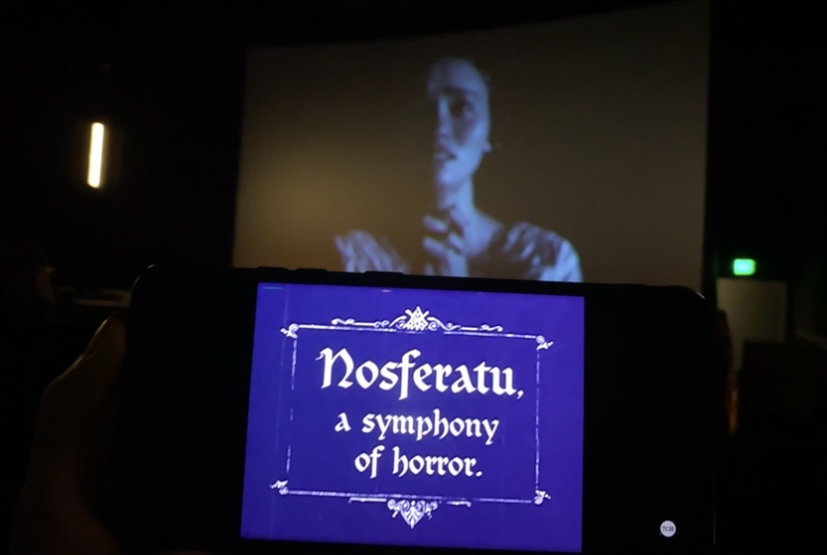Vampires: the romanticized, aestheticized, personification of horror. For countless years, tales of vampires have been frightening people. About a century ago, in 1922, the legend came to life in film, with a silent film ‘Nosferatu: A Symphony of Horror’ being released, scaring viewers sleepless, with another version being created in 1979. And now, the 21st century has its own Nosferatu. Released on Christmas Day, December 25th, 2024, was it a gift for movie enjoyers, or an unwanted lump of coal?
The Nosferatu story is centered on a newlywed couple, deeply in love. The young husband is offered money and a promotion by a real estate agent, and travels to Transylvania to sell a house to Count Orlok, despite his wife’s despair. As he becomes more fearful in Transylvania, his wife, somehow connected to him and/or Orlok begins to act strange, with unexplainable actions, like calling out for her husband and sleepwalking, which doctors blame on a blood condition. When Count Orlok sees a picture of his wife, he’s immediately drawn, and stows away to his new home. Upon reaching the town, a “plague” sets in, yet it is actually Orlok and the real estate agent descending upon the townspeople. Ultimately the wife saves the town, by willfully giving her blood and causing Orlok to stay past the first rooster crow.
The 1922 version is a good balance of both terrifying and entertaining, while the 2024 version is simply shock value, and not even true horror. The 1922 version casts a chilling atmosphere, and tense excitement while being simultaneously humorous. For one thing, it’s full of dramatic irony, such as how the husband writes a letter home denoting the multitude of mosquitos that have been biting his neck. Despite the value of dramatic irony in horror, it’s not really employed in the 2024 version.
On the other hand, the 2024 version is crafted not for the audience to truly fear, but to simply be disturbed. It features things like a man eating a live pigeon, naked monsters, and a lady being eaten by rats, and blood slurping on surround sound. The 1922 version is able to still advance the plot and terrify audiences especially as audiences don’t have to avert their eyes and ears. The use of shadows allows for eeriness and action, while holding the audience captive without shocking them out of the scene. Similarly, the organ/orchestra music in the 1922 version always fits perfectly, and doesn’t get old through the whole film, with the 2024 version being lackluster.
The original uses all they had available, with color filters, microscope images, and costuming. The new version tried to use less technology than they could have, with thousands of live rats, and potato flake snow, which was an impressive, yet questionable, choice. The setting and extras in the 1922 version appear very realistic, while in the new version they seem more staged. The acting in the original is a bit over-the-top, yet it fits well with the dramatic theme and irony. The 2024 version seems more flat, while more conflict is added into the plot, which wasn’t necessary.
Instead of taking the opportunity to provide more clarity without the limitations of silence, the 2024 version was even more confusing than the original. The 1922 version is unrated, but seems to be about PG. However, 2024 is rated R, due to choices that were unnecessary or even detrimental to the plot and atmosphere. Betraying traditional vampire ideas, blood is drunk from the chest, and which leads into the culminating scene where the wife and Nosferatu have sex until morning comes and he burns away. Overall, there is too much nudity, sex, and gore to make this movie enjoyable for most people, unlike the original.
The best thing about the remake is that it follows the original plot very well, even down to the small details, however, the key to the climax is the complete opposite. In the 1922 version, the wife is able to save the town as she is a “sinless maiden,” whereas in the 2024 version, it’s the opposite. Her husband gets tricked into signing her away to Count Orlok, and more significantly, she had been messing around with the occult, and created a connection to Nosferatu when she was younger. Instead of actually fighting evil, the new version seems to be embracing it.
102 years later, ‘Nosferatu: A Symphony of Horror’ is still a classic that almost anyone could enjoy, if they give it a chance. Despite it being a silent film, it’s as clear and involving as any other movie. The remake only adds more conflict, decreases human-human connection, and piles on as many disturbing elements as possible.






